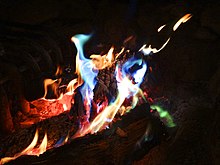What Color Does Sodium Burn

A campfire burning with blue and dark-green flame colorants

Different colors of natural flame from a bunsen burner, without additives
Colored fire is a common pyrotechnic issue used in phase productions, fireworks and past burn performers the world over. Generally, the color of a flame may exist blood-red, orange, blue, yellow, or white, and is dominated past blackbody radiation from soot and steam. When additional chemicals are added to the fuel burning, their atomic emission spectra can affect the frequencies of visible light radiation emitted - in other words, the flame appears in a different color dependent upon the chemical additives. Flame coloring is besides a good manner to demonstrate how fire changes when subjected to heat and how they also modify the matter effectually them.[1] [2]
To colour their flames, pyrotechnicians volition generally use metal salts. Specific combinations of fuels and co-solvents are required in club to deliquesce the necessary chemicals. Color enhancers (commonly chlorine donors) are frequently added likewise, the most mutual of which is polyvinyl chloride. A practical use of colored burn down is the flame examination, where metallic cations are tested by placing the sample in a flame and analyzing the color produced.[3] [4]
Flame colorants [edit]
| Color | Chemical | Image |
|---|---|---|
| Red | Strontium chloride or strontium nitrate |  |
| Orange | Calcium chloride |  |
| Yellow-green | Barium chloride | |
| Orange-xanthous | Sodium chloride (table salt) |  |
| Apple green | Borax (sodium borate) |  |
| Greenish | Copper(II) sulfate and boric acid |  |
| Blue | Copper(I) chloride and butane |  |
| Violet | 3 parts potassium sulfate, 1 part potassium nitrate (saltpeter) | |
| Blue/light violet | Potassium chloride |  |
| White/Yellow | Nitromethane[v] | |
Emitted colors depend on the electronic configuration of the elements involved. Heat free energy from the flame excites electrons to a higher quantum level, and the atoms emit feature colors (photons with energies corresponding to the visible spectrum) as they return to lower energy levels [6]
Campfire colorants [edit]
Flame colorants are becoming popular while camping ground. Scouts[ citation needed ] and other outdoor enthusiasts accept placed sections of copper piping with holes drilled throughout and stuffed with garden hose onto campfires to create a multifariousness of flame colors. An easier method of coloring campfires has been fueled by commercial products. These packages of flame colorants are tossed onto a campfire or into a fireplace to produce effects.
Although these chemicals are very effective at imparting their color into an already existing flame, these substances are non combustible alone. To produce a pulverisation or solid that, when lit, produces a colored flame, the necessary steps are more circuitous. To get a powder to burn satisfactorily, both a fuel and oxidizer will mostly be needed. Common oxidizers include.[7]
- Ammonium perchlorate
- Ammonium nitrate
- Barium chlorate
- Potassium nitrate (saltpeter)
- Potassium chlorate
- Potassium perchlorate
- Strontium nitrate
- Sodium nitrate
Many of these oxidizers also produce a colored flame by themselves. Some of them - likewise as the chief colorants - are severely toxic and therefore environmentally damaging.
References [edit]
- ^ "Blackbody Radiations". Archived from the original on 2014-01-08.
- ^ "Atomic Absorption and Emission Spectra". Archived from the original on 2014-03-26. Retrieved 2014-04-01 .
- ^ "flame tests". Chemguide.co.britain . Retrieved 2017-08-02 .
- ^ "Pyrotechnic Chemicals - Chlorine Donors". Skylighter, Inc . Retrieved 2017-08-02 .
- ^ This flame looks fake but is real (nitromethane) – YouTube
- ^ "Flame Colors as Chemical Indicators". Archived from the original on 2014-10-07. Retrieved 2014-04-01 .
- ^ "Colored Fire Flames". Campfiredude.com . Retrieved 2017-08-02 .
What Color Does Sodium Burn,
Source: https://en.wikipedia.org/wiki/Colored_fire
Posted by: tawneytobt1981.blogspot.com


0 Response to "What Color Does Sodium Burn"
Post a Comment